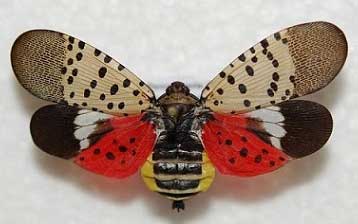NY takes steps to fight spread of spotted lanternfly, which is a threat to agriculture
New quarantine will restrict movement of goods brought into NY from 4 states
Press Release, NYS Department of Agriculture and Markets

Photo by Lawrence Barringer, Pennsylvania Department of Agriculture
The New York State Department of Agriculture and Markets is implementing new actions to protect New York, and its surrounding states, from the establishment of the invasive spotted lanternfly.
The Department, working in collaboration with the State Department of Environmental Conservation, issued a quarantine that will restrict the movement of certain goods brought into New York from Delaware, New Jersey, Pennsylvania, and Virginia, states impacted by the spotted lanternfly. The first SLF findings were reported earlier this month in New York State in Yates and Albany counties.
“The spotted lanternfly is a major concern for us when it comes to our agricultural crops and our forest land, so we can’t take any chances that this invasive species will become established here in New York State,” said State Agriculture Commissioner Richard A. Ball. “The goal of the quarantine we have implemented is to help reduce the opportunities these pests may have in hitching a ride on firewood, plants and other common outdoor items and entering our state in the first place.”
SLF, which is known to do significant damage to agricultural crops as well as plant nurseries and the forest products industries, was first discovered in Pennsylvania in 2014. Established populations of SLF have since been found in New Jersey, Delaware and Virginia.
Two cases of a single reported bug have been confirmed in New York. Given the proximity to the Pennsylvania and New Jersey infestations, NYS is at high risk for infestation. While these insects can jump and fly short distances, they spread primarily through human activity. SLF lay their eggs on any number of surfaces such as vehicles, stone, rusty metal, outdoor furniture and firewood. They can hitch rides on any outdoor item and be easily transported into and throughout New York.
“The newly designated exterior quarantine is part of the State’s aggressive effort to protect our natural resources from the destructive, invasive pest spotted lanternfly,” said DEC Commissioner Basil Seggos. “If this insect becomes established in New York it would threaten our agricultural and tourism industries, including outdoor recreational activities. DEC will continue to work with our state and federal partners to prevent the introduction of this pest into New York State and do what we can to help educate and prepare communities for spotted lanternfly.”
SLF is a destructive pest that feeds on more than 70 plant species including tree-of-heaven (Ailanthus altissima), maples, apple trees, grapevine, and hops. SLF feedings can stress plants, making them vulnerable to disease and attacks from other insects, and cause significant damage to New York’s agricultural industry. SLF also excretes large amounts of sticky “honeydew,” which attracts sooty molds that interfere with plant photosynthesis, negatively affecting the growth and fruit yield of plants. SLF also has the potential to significantly hinder quality of life due to the honeydew and the swarms of insects it attracts.
To help slow the spread of SLF into New York, the quarantine requires certificates of inspection issued from the impacted states on the following regulated articles entering New York State:
• Any living life stage of the SLF.
• Brush, debris, bark, or yard waste.
• Landscaping, remodeling, or construction waste.
• Logs, stumps, or any tree parts.
• Firewood of any species.
• Packing materials, such as wood crates or boxes.
• All plants and plant parts, including but not limited to nursery stock, green lumber, fruit and produce and other material living, dead, cut, fallen (including stumps), roots, branches, mulch, and composted and uncomposted chips.
• Outdoor household articles, including, but not limited to, recreational vehicles, lawn tractors and mowers, mower decks, grills, grill and furniture covers, tarps, mobile homes, tile, stone, deck boards, mobile fire pits, and any equipment associated with these items, and trucks or vehicles not stored indoors.
• Any other article, commodity, item, or product that has or that is reasonably believed to be infested with or harboring SLF.
New York’s order requires travelers transporting any of the above items to have documentation listing the origin and destination of shipments. It also prohibits unnecessarily stops while traveling through the quarantine area. The State Department of Agriculture and Markets will operate compliance checks at strategic locations around the State to enforce the regulations.
The State’s quarantine order was developed in consultation with representatives from the forest products industry, including manufacturers and harvesters, and nurseries/landscapers, orchard and vineyard owners, and others potentially impacted by the restriction. New York also collaborated with other states where quarantines have been enacted to slow the SLF’s spread.
Earlier this month, the Department of Agriculture and Markets and DEC confirmed that SLF was found in Albany and Yates counties. A single adult insect was discovered in a vehicle in the Capital Region and a single adult insect was reported on a private Keuka Lake property in Penn Yan, Yates County.
Following both reported cases, the Department and DEC immediately began extensive surveys throughout the area. The public is encouraged to continue to report any potential sightings of SLF and to send a photo to spottedlanternfly@dec.ny.gov. Please note the location of where the insect was found, egg masses, and/or infestation signs. The public is also encouraged to inspect outdoor items such as vehicles, furniture, and firewood for egg masses. Anyone that visits the Pennsylvania, New Jersey, Delaware and Virginia infested areas should thoroughly inspect their vehicle, luggage and gear for SLF and egg masses before leaving and scrape off all egg masses.
A Smartphone application is also available to help citizens and conservation professionals quickly and easily report new invasive species sightings directly to New York’s invasive species database from their phones. For more information, visit New York’s invasive species database.
The Department, DEC, New York State Office of Parks, Recreation and Historic Preservation and the US Department of Agriculture will continue to survey throughout the Capital District and the Finger Lakes focusing on travel corridors and high-risk areas. Extensive surveys will continue to be conducted in high-risk areas throughout the state as well as inspections of nursery stock, stone shipments, commercial transports, etc., from Pennsylvania. Education to the public as well as industry personnel will also continue. For more information on spotted lanternfly, visit DEC’s website.





































































